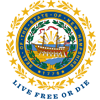Frequently Asked Questions: Health Impacts
Answers to some of the most important questions about PFAS affects on your health.
-
What are the PFOA, PFOS, PFHxS and PFNA health standards for New Hampshire?
-
Are there limits for PFAS other than PFOA, PFOS, PFHxS and PFNA?
-
Can I cook with the water?
-
Can I use the water for bathing, showering or cleaning?
-
Can I irrigate my home-grown vegetables and fruits?
-
Can I use the water to irrigate my lawn?
-
Should I be concerned about my pets?
-
I am a breastfeeding mother drinking water above the PFAS drinking water standards, should I breastfeed my child?
-
What are the PFOA, PFOS, PFHxS and PFNA health standards for New Hampshire?
Maximum Contaminant Level nanograms/liter (part per trillion, or ppt)
- Perfluorooctanoic acid (PFOA) – 12 ppt
- Perfluorooctane sulfonic acid (PFOS) – 15 ppt
- Perfluorohexane sulfonic acid (PFHxS) – 18 ppt
- Perfluorononanoic acid (PFNA) – 11 ppt
-
Are there limits for PFAS other than PFOA, PFOS, PFHxS and PFNA?
The U.S. EPA released final drinking water health advisories for perfluorobutane sulfonic acid (PFBS) and GenX in June 2022, as well as interim (temporary) health advisories for PFOA and PFOS. More information about these EPA health advisories is available on the EPA website. NHDES evaluates the peer-reviewed scientific information and recommendations from federal partners to determine if additional guidance is needed. This includes reviewing toxicological information about novel PFAS and exposure through water, soil, air and wildlife.
-
Can I cook with the water?
If your water is above the current standards, NHDES recommends using an alternative source of water for cooking. Boiling water does not remove the regulated PFAS and may concentrate PFAS into some foods. Consuming foods that contain PFAS increases your overall exposure as ingestion is the primary way PFAS enter the body.
-
Can I use the water for bathing, showering or cleaning?
The NHDES PFAS standards are based on water ingestion because this is the main pathway that PFOA, PFOS, PFNA and PFHxS enter the human body. These standards do not determine a “safe” level for skin contact. Current evidence indicates that showering and bathing is not the primary route of exposure for currently regulated PFAS. In certain occupational scenarios (e.g., firefighters, fluorochemical workers, or other specialty industries), skin contact may present a significant source of exposure due to direct contact with concentrated formulations of PFAS.
-
Can I irrigate my home-grown vegetables and fruits?
The NHDES PFAS standards are not intended as guidance for home gardening. Like other chemical contaminants, certain fruits and vegetables can transfer some PFAS from soil into the leaves, stems and fruits of the plant. The rate at which this occurs in certain produce is currently being studied by universities, as well as state and federal governments to determine if additional guidance is appropriate.
-
Can I use the water to irrigate my lawn?
The NHDES PFAS standards are not intended as guidance for lawn care. NHDES provides guidance for PFOA, PFOS, PFHxS and PFNA in soils based on risks from contact with soil materials. However, the relationship between irrigation water PFAS and soil concentrations is currently unknown. See the NHDES memo: Direct Contact Risk-Based Soil Concentrations of PFOA, PFOS, PFHxS and PFNA.
-
Should I be concerned about my pets?
You should first speak with your veterinarian if you have specific health concerns about your pets. Drinking water standards are developed for the protection of human health, not companion animals. A limited body of research indicates that companion animals (e.g., cats and dogs) are likely exposed to PFAS from drinking water, food, food packaging and various household products. Most animals process or “bioaccumulate” PFAS differently than humans and the exact levels that may cause harm are unknown at this time.
-
I am a breastfeeding mother drinking water above the PFAS drinking water standards, should I breastfeed my child?
Children can be exposed to PFAS through breast milk. Parents with concerns should consult their physicians. However, breastfeeding has many known health benefits, including helping to decrease obesity, building a strong immune system and enhancing brain development. Given the many benefits of breastfeeding for mother and child, breastfeeding continues to be recommended, even if a breastfeeding mother drank water with PFAS above the drinking water standards/MCLs.



